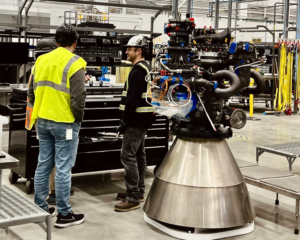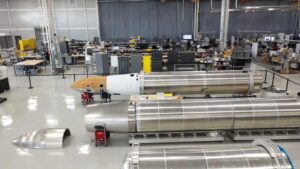
Axiom Station Is Continuing To Make Progress
Axiom Space is trying to create the first commercial space station in low Earth orbit. Following the completion of preliminary and critical design reviews in collaboration with NASA, the company has been very busy in recent months. With an initial segment launch scheduled to happen not far away in 2025, Axiom is pressing forward.
In the last few weeks, we received even more updates on this station and specifically some of the progress on different segments and components. Back in 2020, NASA awarded Axiom a firm-fixed price, indefinite-delivery, indefinite-quantity contract with a maximum potential value, inclusive of options, of $140 million over an up to seven-year ordering period. Right now the company is trying to make use of and provide for the contract.
This comes in addition to more deals between the two with spacesuits and much more. However, focusing back on the station, we are beginning to see real results and physical completion on Hab One and other vital aspects. Here I will go more in-depth into the recent progress from Axiom, the design of this commercial space station, what to expect in the future, and more.
Recent Updates

In order to get the best idea of the progress Axiom is making, we first have to look a few months in the past. Specifically, back in July of this year, Axiom Space tweeted saying, “Progress being made! We continue to move towards building the world’s first commercial space station, Axiom Station. Thanks to @Thales_Alenia_S for helping us turn our vision into a reality. We look forward to the modules’ arrival in Houston for assembly before launch.” This included an image where you could see work on 2 pressurized modules taking shape inside the production area. While exciting, we received even more information just weeks ago.
On November 7th, Thales Alenia Space tweeted mentioning, “Do you recognize it? It’s the @Axiom_Space Station taking shape in @Thales_Alenia_S in #Turin. Walk with us among all the elements of the structure of the first #Axiom Hab!” Axiom Space responded to this and commented, “Global collaboration is built into the core of Axiom Station. Our Italian partners @Thales_Alenia_S continue to make progress on Hab One, the first module being built for the world’s first commercial space station!” This included a video that walked through the facility and gave a closer look at some of the progress being made on different segments.
Following the completion of preliminary and critical design reviews in collaboration with NASA, Axiom’s partners at Thales Alenia Space began welding and machining activities for the primary structures of Axiom Station’s first module. The first pieces of fabricated flight hardware, are beginning to come together. The assembled module will then join Axiom in Houston where they will complete final assembly and integration to prepare for a late 2025 launch of the first section of the next-generation platform for breakthrough innovation in low-Earth orbit.
In terms of the design of this station, it starts with the Axiom Station module hatches which will allow crews to access current and future station elements and visiting vehicles, enabling a dynamic environment for economic activity on orbit. This development unit validates the design’s ability to seal under a predetermined input force. Next, eight of the largest windows ever constructed for the space environment will encircle the Axiom Earth Observatory cupola, allowing Axiom Station’s entire crew to overlook the Earth in 360-degree freedom from orbit. A test unit continues to undergo increasingly extensive vacuum seal and stress testing to confirm the design meets all leak rate, outgassing, and material deformation requirements.
In addition, agile adoption of new technologies has avionics on pace to be Axiom Station’s first flight-ready system and embodies the expert touch that characterizes its next-generation design. Deep into their development, this test bed is used to test, debug, and validate its code. Looking at the core of each module, each Axiom module’s primary structure features four radial bulkheads to which other space station modules and visiting spacecraft can attach, supporting increased traffic and future expansion. The first Axiom module’s bulkheads are well into their machining at our partner Thales Alenia Space’s Turin facility. Finally, Axiom modules are each individual spacecraft equipped with systems need to maneuver in orbit, including propulsion thrusters developed in-house. This test unit continues to cycle through new and progressively longer hot-fire cycles to refine the design.
Station Design & More

Now that we know more about Axiom’s progress and some of the core station components, we can take a closer look at the future plans with NASA and the opportunities Axiom is most excited about. Focusing on the station itself, it starts with the Axiom Hab One, which is the name of the company’s standard station segment. This segment will be used for crew quarters and or research and manufacturing capabilities. The next segment is named Axiom Hab Two. This shares a very similar design to the standard hab with a slight extension on the end. Axiom points out this segment would be used for extended crew quarters and support additional research capacity.
Next is Axiom’s research and manufacturing facility. This includes a few different segments such as an observing room with windows in all directions, and an additional hab specifically for manufacturing purposes. Finally, you have the Axiom Power Thermal Module. On almost all of Axiom Space’s future station renderings, a large tower with solar panels is present. This is the power thermal module expected to provide an extended environment, life support, storage, and payload capabilities. Altogether, this creates Axiom Station, meant to increase access to space and provide a host of unique opportunities in low Earth orbit. It’s important to point out that a lot of the station’s design will likely change over time as Axiom continues to make progress. This being said, it gives us a good idea of what the company is working towards and what we can expect in the future.
Developing commercial destinations in low-Earth orbit is one of five elements of NASA’s plan to open the International Space Station to new commercial and marketing opportunities. The other elements of the five-point plan include efforts to make station and crew resources available for commercial use through a new commercial use and pricing policy; enable private astronaut missions to the station; seek out and pursue opportunities to stimulate long-term, sustainable demand for these services; and quantify NASA’s long-term demand for activities in low-Earth orbit.
“Axiom’s work to develop a commercial destination in space is a critical step for NASA to meet its long-term needs for astronaut training, scientific research, and technology demonstrations in low-Earth orbit,” said NASA Administrator Jim Bridenstine. “We are transforming the way NASA works with industry to benefit the global economy and advance space exploration. It is a similar partnership that this year will return the capability of American astronauts to launch to the space station on American rockets from American soil.” NASA selected Axiom from proposals submitted in response to a solicitation through Appendix I of NASA’s Next Space Technologies for Exploration Partnerships (NextSTEP) 2 Broad Agency Announcement, which offered private industry use of the station utilities and a port to attach one or more commercial elements to the orbiting laboratory.
Because commercial destinations are considered a key element of a robust economy in low-Earth orbit, NASA also plans to issue a final opportunity to partner with the agency in the development of a free-flying, independent commercial destination. Through these combined efforts to develop commercial destinations, NASA is set to meet its long-term needs in low-Earth orbit well beyond the life of the station.
In addition, from the beginning, Axiom has expressed its interest in science and the unique opportunities presented in low Earth orbit. For example, the weightless environment enables the formation of an alloy’s structure to be driven by diffusion as described by Brownian motion rather than gravity driven sedimentation. A diffusion-driven process encourages molecules to be distributed evenly in the material and results in a more uniform microstructure. When an alloy, for example, solidifies on Earth, gravity-driven phenomena such as convection, sedimentation, and hydrostatic pressure can significantly impact the material’s internal microstructure. Non-uniform densities in materials can cause the alloying elements in an alloy to separate during phase transitions. Microgravity offers opportunities to promote uniformity within a material’s microstructure because of its independence from convection, sedimentation, and hydrostatic pressure. This is just one of many unique opportunities presented in low Earth orbit with access to microgravity.
Conclusion
Axiom Space has continued to work on the first commercial space station. In the last few weeks, we learned more about the progress and the construction of some of the initial habitats and habs being created in Italy. Not to mention a host of deals being made with different companies and agencies around the world in relation to this project. We will have to wait and see how it progresses and the impact it has on the space industry.



